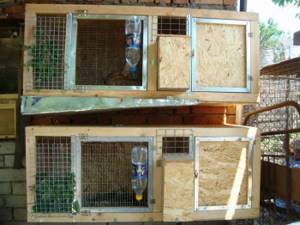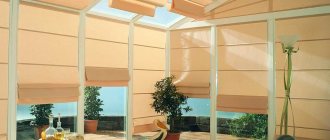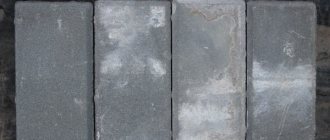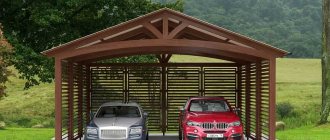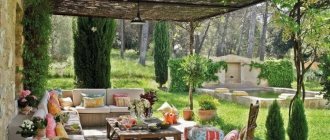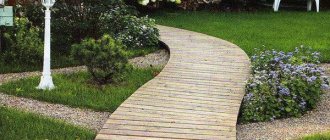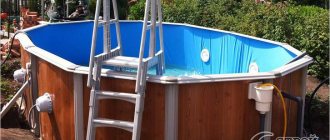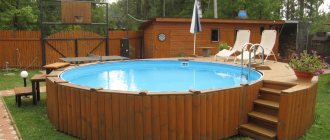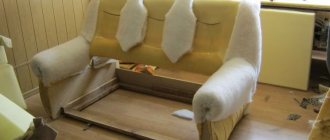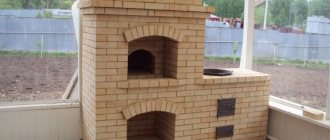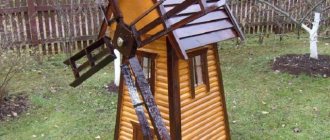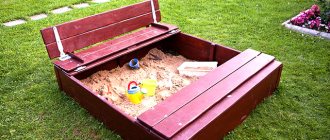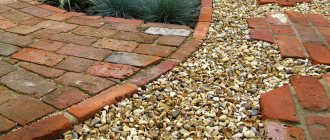Pros and cons of rabbit farming
The advantages of the idea of breeding rabbits are obvious:
- Meat. Rabbit meat is a dietary product useful for people of all ages. It contains a set of amino acids that promote protein synthesis in the human body. In addition, it is low-calorie and natural food.
- Liver. Even though one animal contains only 100 grams of liver, it is a real delicacy.
- Skins. Dressing hides requires not only additional time and knowledge, but also special preparations. It’s not a fact that you will want to spend your time searching and using them.
- Bones and other waste. These products can be cooked and, in the form of a stew, given to the dog.
- Manure. In terms of its qualities, this manure is superior to pig and cow manure, but inferior to horse manure. In spring and autumn it can be added to the soil, and it will respond to you with a glorious harvest.
- Communication. Even the simple contemplation of these cute fluffies gives a lot of positive emotions.
But in the last point of advantages there is already a catch. It’s also worth talking about the disadvantages of rabbit farming:
- Slaughter. Yes, the rabbits will have to be killed. Even if this is a mediocre farm, it makes no sense to hire someone to do this work.
- Mortality. These animals often get sick and are rarely cured. Especially in the summer, when an epidemic wave occurs.
- Accommodation. In this article you will read how to make your own rabbitry, so you can ignore this problem.
- Food. These picky animals won’t eat just anything. They eat up to 30 times a day, but more often the food and drink are simply spoiled by mixing it with waste. Conclusion: there should be a lot of quality food.
- Reproduction. Despite the theoretical fertility of these animals, in practice there may be many offspring, or there may not be any at all.
- Breed. To maintain the population level, a replacement male breeder is required every six months.
Here are the main disadvantages of rabbit farming. If you add to them labor-intensive cleaning, rodent control and the daily need for owners to care for their pets, it becomes clear that rabbit breeding is not an easy matter. If such prospects do not frighten you, let's talk about placing animals.
Rabbit meat is good for the elderly, children, and even the sick: it is a real dietary low-calorie product
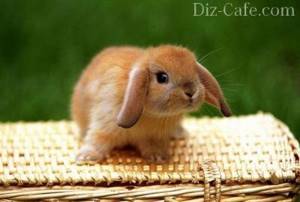
Killing a rabbit is not so easy: you get used to these animals, but there is a way out of the situation. You can breed decorative rabbits for sale
We build an enclosure for rabbits with our own hands
Before starting construction, you need to choose a suitable location for the pen. Preference is given to hills, then water will not get inside after rain or melting snow. The area must be protected from the wind. Many people place the enclosure near one of the walls of outbuildings.
General design requirements:
- fence height – 50-60 cm;
- recommended area – 0.7-0.8 m2 per individual;
- the presence of a canopy;
- protection from undermining;
- houses on the territory of the enclosure.
Planning the future livestock
How to build a good rabbitry without knowing how many rabbits will live in it? If you just want to have animals “for testing”, one rabbit with offspring is enough. They can easily get by with 1-3 cells on the site. In order for the supply of meat to be regular and uninterrupted, 20-30 individuals of different ages of different categories are needed.

To begin with, you can get a few rabbits and care for them throughout the warm season to determine how well this activity fits your plans
Features of keeping rabbits
It cannot be said that caring for these animals is overly difficult, especially when the temperature outside is above zero. Some difficulties may arise with the onset of cold weather. During this period, their life seems to freeze, males lose their potential, females do not reproduce, and their weight decreases significantly. In addition, if animals are kept in a summer-type cage, there is a high probability of colds, hypothermia and even frostbite of some parts of the body. Difficulties also arise with nutrition, it freezes very quickly in feeders, and the liquid turns into ice, but rabbits need regular access to warm water.
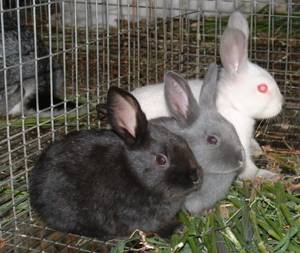
It is also quite problematic to clean the rabbit shed from sewage, because the latter also freezes. All this tells us that we should place the cage with long-eared residents in a barn or, as a last resort, make it heated. True, there are breeds that can easily withstand the harsh Russian winters in outdoor cages. So, before purchasing an individual, be sure to familiarize yourself with the characteristics, care features and choose only the breeds that are suitable for your climatic conditions. However, absolutely all rabbits are afraid of dampness, drafts and temperature changes; take these nuances into account when caring for them.

Optimal rabbitry sizes
There are recommended cage sizes for rabbits. These are the ones we will focus on.
How to keep a couple?
If it is necessary to accommodate two adult individuals, it is enough to build a two-section room. Design parameters:
- length from 140 cm;
- width within 60-70 cm;
- height from 50 to 70 cm.
Along the edges of the structure there are bunker drinkers and feeders. This will make it more difficult for animals to get their paws into them. An inclined net is placed between the sections into which hay can be placed. This internal structure is called a sennik. To save space on the site, the rabbitry can be arranged in two tiers. In addition to being compact, this design allows you to quickly add food to animals and speed up the cleaning procedure.
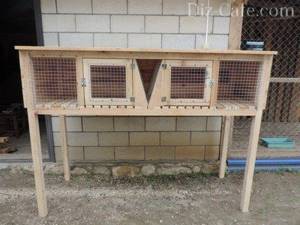
A small cage of two sections is perfect for keeping a couple of rabbits: everything they need is in this building
Group keeping of young animals
A room for young animals is constructed based on the following parameters:
- length approximately 200 – 300 cm;
- width up to 100 cm;
- height ranges from 35 to 60 cm.
For young individuals whose age does not exceed 2 months, it is necessary to calculate the actual volume of cells based on the total number of animals. One such rabbit needs a minimum area of 0.12 m2.
Female and her offspring
To accommodate a female with offspring, you need at least 0.6 m2 of space. For newborn rabbits, a special nesting box is placed in the cage, which must have the following parameters:
- length 35 cm;
- height 30 cm;
- width 25 cm.
In such a box, mother and her rabbits will feel calm.
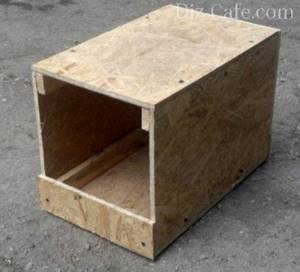
The simplest nest box looks like this, it is not difficult to build. You can put hay or sawdust inside to make the kids feel cozy
What to consider during construction
At the first stage, materials are calculated. You can draw a diagram yourself, which will indicate the location of window and door openings, or use a ready-made drawing of a rabbitry.
The area of the barn is calculated based on the number of livestock. If you plan to keep a large breed, then it will need a cage of 1.5 x 1 m (in width and length). Young animals are given smaller cages.
Need to know. When breeding animals, it will be necessary to seat mature rabbits in separate groups so that females and males are not kept together. This means that additional space for cages will be required.

Drawing of a rabbitry
It is recommended to make a room for storing inventory tools indoors. Some farmers set up a place for feed. A paddock (if necessary) and a manure storage facility are built separately.
Ideal place for a shed
Preference should be given to a site where there is protection from the wind. To prevent animals from suffering from the heat in the summer, you can build a barn next to the northern wall of a residential building. It is worth considering that you will have to dig a pit for the foundation, and therefore groundwater should not lie close to the surface.
How to build
If you plan to create a lightweight structure, then significant savings are achieved on the foundation. The construction of brick walls will ensure the durability of the building, but will entail an increase in cash costs.
You can limit yourself to a wooden shed; here you need to make a frame and use lumber for cladding. Floors are sloping to make cleaning easier. The room is additionally insulated with thermal insulation materials. To prevent drafts, doors and windows should be tightly closed.
Construction of a cell
The standard version has a timber frame; it must be sheathed with thick plywood on the sides, back and top. The front side and bottom are made of mesh. The floors and roof should have a slight slope. Very often the lids are made to be hinged, and therefore you need to attach hinges on one edge. If there is no canopy for outdoor maintenance, the roof is made with a 20-centimeter canopy.
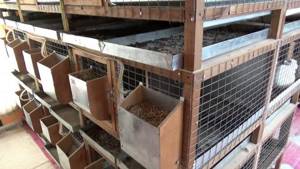
Rabbit cages
To facilitate animal care, the cages are raised to a height of about 0.7 meters and trays are installed underneath to collect waste. This option involves boarding one or two adult animals.
The cage for females is made with a uterine compartment, one zone is separated from the other by plywood. Half of the space is allocated for the living area, and the other for breeding young animals. The queen cell itself is made with solid walls so that the baby rabbits cannot accidentally fall out onto the floor. The plywood partition is equipped with a hole having a diameter of 20 cm and is placed at a height of 15 cm.
What building material should be used?
To build a rabbitry you need relatively inexpensive but durable material. Please note that for all their cuteness, your future pets are rodents. This means that they will absolutely test any construction to the teeth.

Rabbits are rodents, so the internal bars made of wood must be protected from their attacks. It's easy to make protection from tin
If you want those parts of the frame that are made of wood to last more than one season, cover them with metal. In order not to buy it specifically, you can use tin from beer cans or galvanized steel for roofing work for these purposes. This additional work will not take much time, but the useful life of the cells will increase by ten years, or even more.
The most inexpensive and simple material for the frame is wood blocks, the cross-section of which is 50x50 mm. Wood should not be impregnated with an antiseptic. This impregnation is toxic enough to poison young animals. It is better to dry the frame thoroughly. This increases its durability.
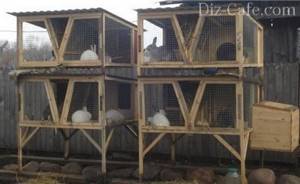
A rabbitry with a frame made of well-dried wood can be considered the most economical design: it will last you more than one season
For the roof of each tier of the structure it is necessary to take moisture-resistant material. Flat or wavy slate is perfect for this purpose. If the structure will be located on the street, do not use metal for its roof. This material has the unpleasant property of getting very hot in the sun. As a result, the cell actually turns into an oven.
Now you need to choose the material for covering the frame. For this purpose, a galvanized chain-link mesh with a cell size of 20x20 mm is best suited. By the way, the chain-link itself got its name from the word “rabbit” pronounced in English.
Steel mesh is used for the side of the structure, its doors and facade. The compartment for storing hay - the hay barn, located between the sections - must be made of mesh, the cells of which have a size of 50x50 mm. This will make it easier for animals to get the food they need.
Recent Entries
5 working ways to use tar in the garden 7 indoor plants that help you get married even in adulthood Indoor plants that can bloom in trouble
For the bottom, a flat galvanized mesh with cells of 25x25 mm or 10x25 mm is used. Its installation is carried out on load-bearing wooden slats. This solution allows you to do cleaning much faster. Rabbit feces simply fall through large enough cells. It does not stick to wood or galvanized surfaces, which would have to be scraped off each time. The accumulation of manure occurs either in a special receiving bunker, or on the ground if it rolls down the inclined surface of the roof of the lower tier of the structure.
As a rule, continuous flooring is not used for rabbitry. The reason is that wood immediately absorbs caustic urine, and feces simply stick to it. As a result, the microclimate in the cage worsens, and the boards begin to quickly rot. Therefore, it is better to make the bottom lattice. For this, planed floor bars are used. The gap between adjacent bars does not exceed 1 cm.

This photo clearly shows the slatted floor; each slatted floor is reliably protected from rodent teeth by small strips of metal
Rabbits cannot tolerate drafts and can get sick. To prevent this from happening, the rear wall of the structure is made blank. To create it, you can use polycarbonate, boards, simple plywood or OSB board.
If the structure will be located on the street, its supporting frame is made of metal. So, the supporting structure is welded from a corner with parameters 45x45 mm. After which it is simply filled with ready-made sections assembled from stamped mesh. The mesh must be secured to frames welded from steel rod. Another option is a wooden frame. Read below how to make it.
You need to know that animals may develop calluses on their paws; they bring suffering to the animal. To prevent this from happening, you can install a small plywood sheet on the floor to protect the paws. But such plywood must be periodically removed, cleaned and thoroughly dried.

An element such as plywood is needed only in those cages whose floor is made entirely of flat mesh. It is necessary to prevent rabbits from developing corns.
The net will not be able to protect animals from rain or snow. It is better to place such a cage under a slate canopy or in a barn.
Rules for caring for the enclosure
Maintaining cleanliness and order in the places where rabbits live is the key to successful breeding. Among the recommendations that will help organize comfort in the pens are the following:
- To prevent the scattering of feed, feeders should be attached to the side walls.
- Any accidentally dropped food on the floor should be removed immediately, as it can cause illness.
- Remove manure daily.
- Once a week it is recommended to wash all equipment and disinfect it with antiseptics.
- Disinfect the entire enclosure every month.
Video Construction of a large enclosure for rabbits
A little about Zolotukhin’s method
Nikolai Ivanovich Zolotukhin has been breeding fur-bearing animals for many years, has studied their habits well and, summarizing his experience, has created his own method of effectively equipping rabbitries.
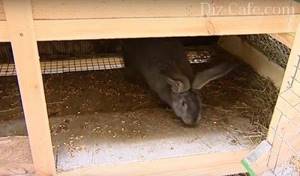
The combined floor looks exactly like this: a slightly sloping large solid front part and a 15-20 cm wide mesh at the back wall of the rabbitry
Zolotukhin suggests:
- Make the floor combined: its front part will be in the form of an inclined flooring made of flat slate, and the back part should be made of steel mesh;
- The feeders into which grain is poured are made not just of hoppers, but of a rotating design: in this case, they will be easy not only to fill, but also to clean.
Zolotukhin chose such a non-standard floor surface not by chance, but on the basis of reliable statistical data and his own observations. Approximately 95% of rabbits relieve themselves at the back wall of the cage. Just where the grid is located. 70% of feces end up there. The animals scatter the rest of the feces all over the floor, but it is dry, so sweeping it up is much easier.
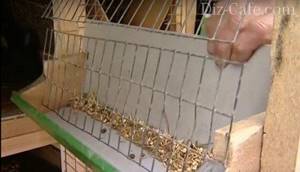
A simple rotary feeder from Zolotukhin differs from a regular bunker feeder in that it can be deployed by slightly pulling towards you
Nikolai Ivanovich uses bedding that would absorb moisture only to teach young animals to urinate at the back wall of the room. His buildings are always dry, and he has to spend less time cleaning than others. For more information about the Zolotukhin method, watch the video.
Which cage floor is best for rabbits?
Today, when arranging a rabbitry, rabbit breeders use a variety of materials, so it is not surprising that among the popular types of bottoms are metal mesh and wooden slatted floors.
Slightly less common are structures made of flat slate, OSB, perforated steel sheets, as well as plastic surfaces. Of course, each of the listed options has its own advantages and disadvantages, information about which will be very useful when choosing. Let's take a closer look at them.
Find out how to make a rabbitry, cages for rabbits using the Zolotukhin method, sheds for rabbits, queen cells.
Reticulate
The mesh floor in the rabbitry at one time became a good alternative to wooden surfaces. Usually it is made of stamped metal mesh - but not chain-link, since the latter causes corns and unpleasant sensations in animals (it pinches the hairs on the paws).
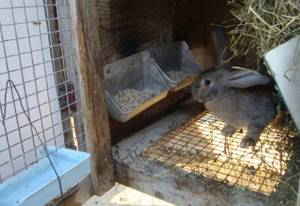
The main advantages of mesh floors include the following:
- durability of the material;
- almost instantaneous removal of all excrement, which has a positive effect on the health of eared animals;
- additional ventilation in the summer (rabbits sweat through the pads on their paws);
- availability of mesh material and reduction in the final cost of all cells.
With a competent approach to installing a mesh floor, no problems with its operation should arise.
Important! To minimize the possible risk of paw damage, part of the mesh floor of the cage can be covered with a sheet of plywood on which the animal can rest. This removable covering can be easily cleaned if necessary, so there is no need to worry about hygiene.
Wooden slatted floor
Many rabbit breeders consider wooden slatted floors more convenient for animals, however, maintaining order in them is not so easy. Today, there are 2 main types of such bottoms: inserted and inclined.
Plug-in
Inserted, that is, removable floors, can certainly be called a much more profitable and convenient solution than stationary ones. When completely disinfecting the cells or performing another small cleaning, they are much easier to take out and clean, and even a schoolchild can handle the construction of such a structure.
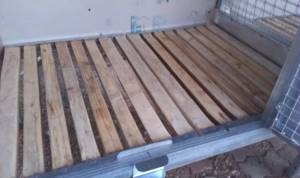
The width of the slats is usually about 4.5 cm, and the thickness of the bars varies from 3 to 4 cm. Having placed the required number of parts nearby, all you have to do is fix them together with additional bars, nailed either only on two sides or along the entire perimeter. It is necessary to leave 2–2.5 cm of free space between the slats to remove urine and excrement from the cage.
Important! To prevent the wood from rotting quickly, it is advisable to cover it with a special wax oil or other similar composition (but only with a minimum level of toxicity). Treated inserts can be placed in the cage only after they are completely dry and ventilated.
With inclined slats
As an acceptable alternative to horizontal wooden slats, you can construct a rabbitry floor with inclined slats. With them it will be much more convenient to clean and remove dirt, since the movement of the scraper at an angle is much more effective and requires much less physical effort. If the owner of the rabbits is right-handed, then the slats should “move” away from you to the left, while for left-handed people - to the right.

The positive aspects of this particular solution include a reduction in the cost of consumables due to the possibility of using even the smallest blocks (they will take up space in the corners). If we take into account the need to periodically change inserted floors, the savings will be more than noticeable, and with an increase in the number of cells, the saved money will only accumulate.
Familiarize yourself with the basic principles of hygiene for keeping rabbits.
Plastic
Relatively recently, plastic floors for cages of various animals have appeared in markets and specialized stores. They consist of many collapsible parts and can be easily adjusted to the required space parameters, while having all the advantages of the previous options. Moreover, they are also high-tech in terms of cleaning, and in winter they seem much warmer than other options.

Of course, when carrying out disinfection, it will not be possible to burn them with a blowtorch (it is sometimes used to disinfect mesh floors), but most manufacturers assure that it is possible to scald with boiling water and use standard liquid antiseptics.
Important! When choosing a plastic floor for a rabbitry, be guided by the declared strength indicators. Despite the fact that most of these floors successfully support medium and even large rabbits, animals of giant breeds can break a low-quality stand, and in the shortest possible time.
Flat slate or OSB boards
Flat slate and OSB boards are successfully used in cages created according to Zolotukhin’s method. They are presented in the form of a multi-tiered structure with solid floors that do not allow excrement, water and urine to penetrate to the lower floors. Moreover, cleaning such rabbit houses will take much less time than in other varieties, which was achieved thanks to the advantageous location of the cages.

The principle of self-cleaning is based on the fact that each upper tier protrudes several centimeters above the lower floor, as if hanging over it from behind. The floors in all rooms are placed at a slight angle, and in the place of the protruding part, nets are attached, through which garbage and feces are removed outside (they fall into a tray).
With this design of a rabbit hutch, the most convenient material for creating a floor will be flat slate: it is durable, rabbits will not be able to chew through it, and cleaning the surface will not take much effort. Almost the only drawback of this solution is that large animals can develop calluses on their paws due to constant exposure to a hard surface.
Learn how to make bunker feeders and waterers for rabbits.
A softer and more convenient solution in this regard would be OSB board, a popular material obtained by pressing rectangular wood chips under high pressure. In many respects it is superior to plywood and standard boards, in particular it holds nails or screws well.
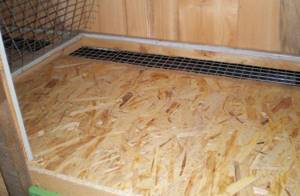
When choosing OSB boards, be guided by the type OSB-3, it has good moisture and wear resistance. The advantages of OSB boards in the construction of rabbit hutches include:
- high level of moisture resistance (you can choose the material with the most favorable indicators, for example, OSB-3);
- maintaining the strength of the floor over a long period of use;
- affordable cost (cheaper than quality boards);
- ease of use (you can create almost anything from them, since OSB boards are easy to cut and connect to each other and to other materials).
Creating a floor in a rabbitry from OSB boards is a profitable solution, especially if you still decide to adhere to Zolotukhin’s method.
Did you know? Rabbit feces are considered a valuable fertilizer for plants, as they contain one and a half times more nitrogen and potassium than other natural fertilizers. And in addition to this, it is worth noting the impossibility of spreading weed seeds, since they simply are not present in the feces of long-eared animals.
Perforated stainless steel sheets or rolls
Much less often than other presented materials, perforated stainless steel sheets or rolls of perforated strips made of the same stainless steel are used. True, it is important that the size of the existing holes fully meets the requirements of rabbit breeding, ensuring the free passage of debris and excrement.
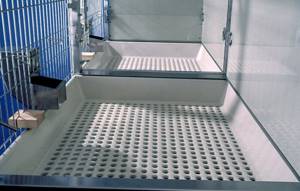
Perforated floor for rabbits in a purchased rabbitry One of the suitable options would be holes with a cross-section of 1.5 cm, although even in this case large particles often clump together and get stuck, thereby only complicating the cleaning process.
Did you know? Female rabbits rarely give birth to even 20 little rabbits, but the largest officially recorded litter is considered to be 24 little rabbits.
The advantages of using these particular materials for floor construction are as follows:
- long service life (stainless steel is highly resistant to even the most aggressive rabbitry environments: urine, roasting and disinfectants);
- speed of cage installation (you just need to measure the appropriate length of strip in a roll, and then nail or screw it to the frame base);
- ease of replacement of material (when the used piece wears out a little, it can be easily replaced with a new one).

In addition, in the cold winter it is very difficult to stay warm on such floors, and this affects the comfort and even the health of rabbits. Such a covering is not suitable for rabbits at all: if they get their paw into the hole in the leaf, they can damage their limb. Find out what grass can poison rabbits, whether they can eat burdock, wormwood, nettle, bran, cereals, bread.
Let's start building the rabbitry
To accurately calculate the consumption of materials needed to set up a rabbitry, you need to either use a ready-made drawing or make your own sketch based on the dimensions suggested above. After purchasing the material, you can start working.
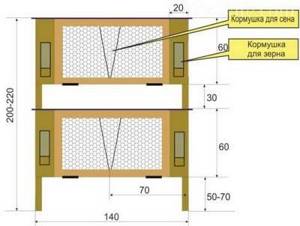
This is a drawing of a two-tier, two-section cage that can accommodate four adult rabbits. It is equipped with an intersectional hay barn, drinking bowls and bunker feeders.
If the frame is wooden, cut the slats to size and connect them using self-tapping screws. Be sure to make sure there are no distortions. To do this, we check horizontal surfaces with a level, and vertical surfaces with a square. First we assemble the front and rear frames. Now, using short ceiling and floor jumpers, we connect them into a single structure.

If you look at the rabbitry from the side, you can clearly see exactly how its roof needs to be made so that it is sloping
The frame is ready. Now we install the bars of the hay barn and doors. We lay the slatted floor, not forgetting that the gap between its elements should not exceed 10 mm. After completing this work, we cut the mesh and plywood to attach them to the frame with self-tapping screws.
Now let's lay the roof. For the first level of the roof, you can use moisture-resistant QSB sheet. We cut it so that the edge of the sheet protrudes 10-15 cm beyond the dimensions of the cage. To build the second tier, we take corrugated slate. It is attached to the inclined bars of the frame itself.
All that remains is to install OSB doors, drinkers and bunker feeders. The work is completed. Watch the video, it will help you with your work:
Design requirements
Rabbit pens are always individual in size. This is influenced by the number of heads and physiological characteristics of the animals. As already mentioned, it is advisable to dig the side fences a little deeper into the ground. The walls are made of such a height that the little ear can easily stand tall - this is minimal, but it can be higher.
There should be no overcrowding of animals in the pen, because this leads to stress, fights and injuries. If the territory has an area of 20 square meters. m, then you can place 5 females and 20-30 rabbits there. Or, as an option, only 25 young rabbits removed.

If the rabbits have never been brought into the pen, then they are accustomed to walking from 2.5-3 months, in spring or autumn. Adult males can be bred to females, but only if there are 10 times fewer rabbits. If animals are being bred for breeding, then in a pen you can keep 1 male for every 5-10 females.
In such walking areas for rabbits, you can install houses or cages, and feeders are also provided there.
Next we will tell you how to make a pen for rabbits with your own hands. We will consider a portable type device made of iron mesh. It should be taken into account that 1 rabbit accounts for 1 sq.m of area.
A standard indoor rabbitry is an enclosed room equipped with lighting, ventilation and heating systems, and, less commonly, a water supply system. There are cages in long rows, usually in three tiers. Between them there are passages, the optimal width of which is 1.5 m. Often part of the rabbitry is separated for technical rooms and feed storage.
We invite you to read: How to make a duck house (room, barn) for keeping ducks with your own hands: photo
This design has proven itself well in central Russia and the south; in colder areas it should be used with caution.
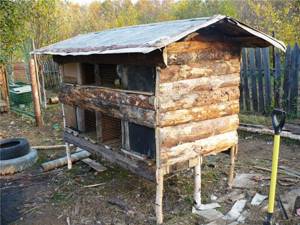
An example of an inexpensive homemade mini-farm
It is recommended to raise its structure 1 m from ground level. This is most easily achieved with extended legs. A correctly built frame does not require additional piles.
Rabbit hutch in a hole
This is one of the most controversial decisions; there are approximately equal numbers of supporters and opponents of this design.
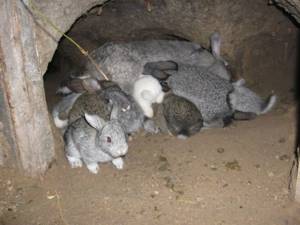
An example of “pit” rabbit keeping
Pros of “pit” content:
- life in burrows is natural for rabbits;
- in the pits a microclimate, humidity and temperature that is normal for rabbits is naturally formed;
- animals breed all year round;
- good litter survival;
- animals get sick less often and gain weight better;
- feed is given to all animals at once, this saves time and effort.
Disadvantages of “pit” content:
- it is impossible to regulate mating;
- it is difficult to monitor the condition of individual individuals;
- difficult to catch animals;
- there is a possibility that the rabbits will dig under the walls and escape.
Example No. 1 of keeping rabbits in pits Example No. 2 of keeping rabbits in pits Example No. 3 of keeping rabbits in pits
For pit-keeping in a rabbitry, a hole with a depth of 1 to 2 meters is dug around the entire perimeter. The floor and walls are concreted to prevent escapes. The resulting hole is filled with sand approximately 20 cm thick, on which a net is laid for easy cleaning. Feeders and drinking bowls are placed inside, and you can let rabbits in.
The climate of Russia is such that in most of its territory the winter is too cold for keeping rodents outdoors or in uninsulated rooms. Therefore, to successfully keep rabbits, you need to think about insulation. There are two options here, and to achieve the best result they must be combined. Either heat the rabbitry or insulate the compartments themselves in which the animals are kept.

In cold weather, it is necessary to monitor the temperature in the rabbitry, otherwise the rodents will die from the cold
In the queen cell, the temperature should not fall below 10 degrees, otherwise the rabbits may die, or, under the best circumstances, they will lag significantly behind in development, and the farmer will spend more on maintaining the young than he will ultimately make a profit. It must be taken into account that rabbits are born naked and are very sensitive to cold.
Russian rabbit breeders came up with an original way to insulate compartments. A “pocket” made of thick plywood is attached to the bottom of the compartment, into which an EG-1 (or other) electric heating pad is placed. Using a transformer, if necessary, the heating pad is switched to a reduced mode, thereby heating the floor of the cage.
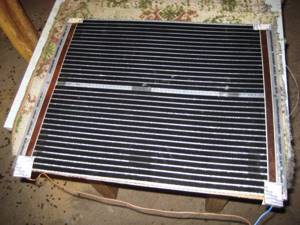
An example of a heating element that is attached to the bottom of a queen cell to maintain heat during the cold season
Two-section cage
It is not advisable to make a cage into one section: low hygiene, spartan conditions for delicate animals. Rabbit breeders have almost abandoned it, although it is very easy to manufacture.
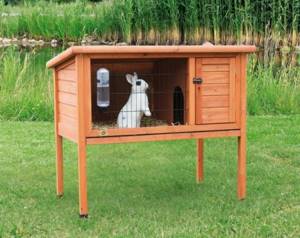
The two-section cage is very popular, and in the media you can find various versions of the photo of the rabbitry. It’s not difficult to build one with your own hands. This type of rabbitry is a box almost 2 meters long. The height is made a little more than half a meter; and the same depth. The five sides of the box are made solid, from unpainted sanded boards.
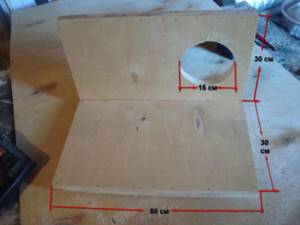
Having measured 2/3, make a partition with a hole cut out, or make it in two parts. The large section is intended for walking and feeding. In a smaller part, rabbits usually rest. This type of rabbitry is also called group.
